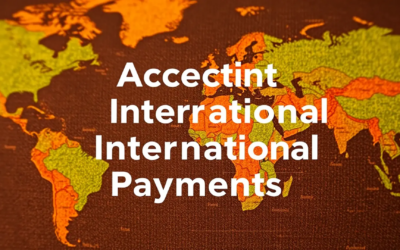Everything a Business Needs to Know About Credit Card Processing Gateways
Are your customers leaving their carts because paying is too slow or confusing? In today’s online world, customers expect a quick and secure way to pay, especially with their credit cards. If they don’t get that, they might just give up and go somewhere else. A credit card processing gateway can solve this by making the payment process smooth, safe, and reliable. This technology acts like a middleman, handling sensitive information securely and keeping transactions fast and simple. With the right gateway in place, businesses can build trust, keep customers happy, and boost sales without breaking a sweat.
What is a Credit Card Processing Gateway?
A credit card processing gateway is a tool that lets businesses accept credit card payments safely. It’s like a digital bridge connecting your customer’s bank and your business. When a customer pays, the gateway securely handles their payment information and sends it along to make sure the funds go through.
This gateway plays a major role in both online and in-store transactions. Think of it as an essential part of online shopping that makes card payments possible. For physical stores, it’s built into the point-of-sale (POS) systems that process cards directly at the checkout counter.
In the past, credit card transactions were handled manually, often with simple card readers. However, as online shopping grew, these systems evolved into complex digital gateways packed with security features. Today’s gateways work for both online and in-person purchases and use advanced technology to keep payments secure. Whether you’re a small business or a big retailer, a credit card processing gateway is crucial for handling payments smoothly and securely.
How Credit Card Processing Gateways Work
Here’s a breakdown of how a credit card processing gateway works to complete payment:
- Customer initiates payment: It starts when a customer decides to pay by credit card, either by entering their info online or swiping/tapping their card at a store’s checkout.
- Gateway encrypts and sends data to the payment processor: The gateway takes the payment details, locks them up with encryption (to keep them secure), and sends them to the payment processor. This processor is the system that actually handles the movement of money.
- Processor communicates with the issuing bank: Next, the payment processor contacts the customer’s bank (the bank that issued the credit card) to check if there are enough funds and if the account is valid.
- Authorization or decline returned to the merchant: Based on the bank’s response, the payment processor sends a message back through the gateway to the business. If everything checks out, the payment is approved; if not, it’s declined.
- Completion of the transaction: If approved, the transaction is finalized, with the funds moving from the customer’s account to the business. The merchant’s system marks the payment as complete, allowing the sale to go through.
Security Protocols in Place
Credit card processing gateways use multiple security measures to keep payments safe. Here’s how they work:
Encryption
Encryption scrambles the payment data so that only authorized systems can read it. This protects customer info as it moves from their bank to the business.
Tokenization
Tokenization swaps sensitive card details with a random set of characters (or a “token”) that has no real value to hackers. If someone tries to steal it, they’ll get gibberish instead of useful card data.
SSL (Secure Socket Layer)
SSL secures the connection between the customer’s device and the gateway so no one can snoop on the data being transmitted. It’s like putting the info in a locked box to protect it from prying eyes.
These security features play a huge role in protecting both customers and businesses from fraud, helping to build trust with every transaction.
The Different Types of Credit Card Processing Gateways
Different businesses have different needs, so credit card processing gateways come in a few varieties. Each type has its strengths, and some come with certain trade-offs. Here’s a look at the main options:
Hosted Payment Gateways
A hosted payment gateway sends customers to a third-party site to finish paying. Think of it like stepping into a separate room to complete the payment; this room is secure and managed by another company.
Benefits
Hosted gateways come with strong built-in security features and take care of PCI compliance (a major set of rules for payment security), which reduces the burden on the business.
Drawbacks
Since customers leave the business’s site to pay, it can sometimes disrupt the shopping experience. If customers feel uneasy about being redirected, they might abandon the cart.
Integrated (Non-Hosted) Payment Gateways
An integrated gateway allows customers to complete the payment directly on the business’s site or app without being redirected elsewhere.
Benefits
Since customers stay on the same website or app, the experience feels smooth and professional, which can help with customer trust and sales.
Drawbacks
With an integrated gateway, the business needs to handle PCI compliance, which involves following strict security standards. This can mean more work and responsibility.
Self-Hosted Payment Gateways
A self-hosted gateway gives a business complete control over the payment process, allowing for a fully customized experience.
Pros
This setup lets businesses control the entire checkout process, from design to how payments are processed, creating a branded experience.
Cons
Managing a self-hosted gateway is complex and requires technical resources. Also, the business has to handle all PCI compliance requirements, which can be time-consuming and costly.
Key Features of a Credit Card Processing Gateway
When choosing a credit card processing gateway, certain features stand out to ensure smooth, secure, and reliable payments. Let’s go over the key ones.
Security Features
One of the most important aspects of a payment gateway is security. Gateways are required to comply with PCI DSS (Payment Card Industry Data Security Standard), a set of strict rules that keep payment data safe from theft. Compliance means the gateway follows standards to protect sensitive customer information, giving both businesses and customers peace of mind.
Other essential security features include tokenization and fraud detection. Tokenization replaces actual card details with a unique “token,” keeping the real data safe and reducing the risk of fraud. Fraud detection tools work in real-time, scanning for unusual activities to stop potential fraud before it happens. And of course, encryption is a must, scrambling data during transactions so that only authorized parties can read it.
Speed and Performance
A gateway’s speed is critical for customer satisfaction. Slow processing can frustrate customers, causing them to abandon their carts and maybe even hesitate to shop with that business again. Fast gateways reduce wait times, making sure transactions go through quickly so customers can complete their purchases without hassle. For online shopping, every second counts in making the process smooth and enjoyable.
Seamless Integration
For businesses, a good gateway should fit right in with other systems, such as e-commerce platforms, accounting software, and CRM (customer relationship management) tools. Integration with these systems means a unified data flow, which simplifies accounting and lets customer details be tracked smoothly. When everything’s connected, it’s easier for businesses to keep track of sales and offer better service.
Customer Support and Service
When things go wrong, 24/7 customer support can be a lifesaver. If a customer has trouble completing a payment or if there’s a technical issue, having access to reliable support can help solve problems quickly and prevent lost sales. Strong support also matters for handling disputes or troubleshooting complex issues, helping businesses keep transactions running smoothly without delay.
The Security and Compliance Standards in Credit Card Processing Gateways
PCI DSS Compliance
PCI DSS (Payment Card Industry Data Security Standard) is the main security standard all credit card processing gateways must meet. This compliance is mandatory to ensure cardholder data is kept safe throughout each transaction. For a business, using a PCI-compliant gateway is essential to avoid hefty fines and protect both itself and its customers.
Businesses should also understand that maintaining PCI compliance isn’t just the gateway’s responsibility. They must follow certain practices, like not storing sensitive card data on their systems unless it’s properly secured and updated.
Additional Security Layers
To add extra protection, many gateways offer additional security layers, like two-factor authentication and enhanced encryption standards. Two-factor authentication requires an extra step, such as a code sent to the customer’s phone, making it harder for hackers to access accounts.
Encryption standards, meanwhile, help secure payment data so that it can’t be easily accessed if intercepted. Educating customers about these practices can also build their confidence, as they’ll know they’re making payments in a secure environment.
The Benefits of Using a Credit Card Processing Gateway
Credit card processing gateways provide several key advantages for businesses and customers.
Improved Customer Experience
A good gateway ensures that payments are smooth and reliable, reducing checkout time and increasing convenience. With faster transactions, customers are more likely to complete their purchases, leading to better sales for the business.
Fraud Reduction
Gateways play a significant role in reducing fraud by monitoring transactions for suspicious activity and preventing unauthorized access. Features like tokenization and real-time fraud detection work together to protect both the business and its customers.
Operational Efficiency
Gateways can save businesses time and reduce human errors by automating many parts of the payment process. This streamlined approach helps with tasks like transaction tracking and reconciliation, making accounting easier and more accurate. Plus, with an efficient gateway, businesses can focus more on growth instead of dealing with payment issues.
The Challenges Businesses Face with Credit Card Processing Gateways
While gateways offer many benefits, there are challenges that businesses should be aware of.
Hidden Fees and Pricing Complexities
Gateways can come with complex fee structures, including flat rates or interchange-plus pricing. These fees vary depending on factors like transaction volume and the type of business. Hidden fees or unclear pricing can add up, affecting a business’s profits, so it’s crucial to understand a gateway’s cost structure before choosing one.
Data Breaches and Security Risks
If a gateway isn’t properly secured, it can leave a business vulnerable to data breaches. Some high-profile breaches show the risks involved if security measures aren’t maintained. Regular security updates and compliance checks are necessary to prevent such incidents and protect sensitive customer data.
Integration Limitations
Certain gateways may not work well with specific platforms or software. This lack of compatibility can be a roadblock for businesses, especially those using specialized systems. In these cases, custom solutions might be required, which could mean additional time, effort, and cost to get everything working together.
How to Choose the Right Credit Card Processing Gateway for Your Business
Choosing a gateway depends on several factors unique to each business.
Assess Your Business Needs
Think about your transaction volume, target customers, and security requirements. A small business might want a simple, low-cost gateway, while a larger one may need advanced features to handle high-volume transactions and maintain customer security.
Compare Pricing and Fees
Compare the pricing models available, such as flat-rate or interchange-plus. Look for transparency in fees so you know exactly what you’re paying for and can avoid any surprises.
Evaluate Security Features
Ensure the gateway offers essential security features like PCI compliance, encryption, and tokenization. Regular security updates and reviews are also important to keep your payment system safe.
Check for Compatibility and Support
Make sure the gateway works smoothly with your current e-commerce platform and accounting tools. Also, consider gateways that provide reliable customer support, as this can be crucial for resolving issues quickly.
Summing Up
In today’s digital world, a credit card processing gateway is essential for safe, reliable, and fast payment handling. Choosing the right gateway can boost your business’s security, improve customer experience, and increase sales. By understanding the key features, benefits, and potential challenges, businesses can make an informed choice that supports growth and builds trust with customers. With the right payment gateway in place, handling payments becomes easier, and customers are more likely to return, helping your business thrive.
FAQs
What is a Credit Gateway?
A credit gateway is a service that authorizes credit transactions for businesses, ensuring payments are processed securely between customers and banks. It’s essential for online and in-store purchases.
Is Mastercard a Gateway?
No, Mastercard isn’t a gateway. It’s a card network that connects banks and card issuers. Gateways, on the other hand, handle the actual processing of transactions.
What is the Difference Between a Credit Card Gateway and a Processor?
A gateway securely sends payment info, while a processor handles the transfer of funds between banks. Both work together to complete credit card transactions.
Do Credit Card Gateways Store Customer Information?
Most gateways don’t store sensitive card details. Instead, they use tokenization and encryption to protect data during transactions, which keeps customer information secure.
Can a Credit Card Processing Gateway Handle International Payments?
Yes, many gateways can process international payments, but fees and processing times may vary. It’s essential to check if the gateway supports multiple currencies and countries.







